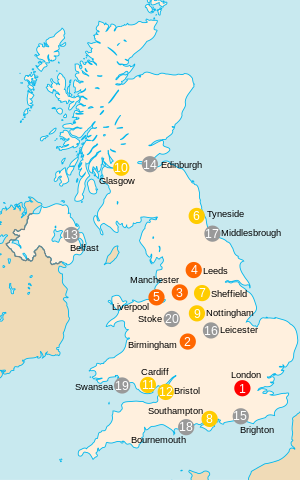
A metropolitan area or metro is a region consisting of a densely populated urban agglomeration and its surrounding territories which are sharing industries, commercial areas, transport network, infrastructures and housing. A metropolitan area usually comprises multiple principal cities, jurisdictions and municipalities: neighborhoods, townships, boroughs, cities, towns, exurbs, suburbs, counties, districts and even states and nations in areas like the eurodistricts. As social, economic and political institutions have changed, metropolitan areas have become key economic and political regions.

The Katowice-Ostrava metropolitan area is a polycentric metropolitan area in southern Poland and northeastern Czech Republic, centered on the cities of Katowice and Ostrava, and has around 5 million inhabitants. Geographically, it is located mainly in Upper Silesia, with small parts of the area also in the historical regions of Moravia and Lesser Poland. Administratively, it is located in the three administrative units : mainly Silesian Voivodeship and a small western part of Lesser Poland Voivodeship in Poland, and also a small eastern part of Moravian-Silesian Region in the Czech Republic.

The London metropolitan area is the metropolitan area of London, England. It has several definitions, including the London Travel to Work Area, and usually consists of the London urban area, settlements that share London's infrastructure, and places from which it is practicable to commute to work in London. It is also known as the London commuter belt, or Southeast metropolitan area.

The Nottingham Built-up Area (BUA), Nottingham Urban Area, or Greater Nottingham is an area of land defined by the Office for National Statistics as built-up land with a minimum area of 20 hectares, while settlements within 200 metres of each other are linked. It consists of the city of Nottingham and the adjoining urban areas of Nottinghamshire and Derbyshire, in the East Midlands of England. It had a total population of 729,977 at the time of the 2011 census. This was an increase of almost 10% since the 2001 census recorded population of 666,358, due to population increases, reductions and several new sub-divisions.

South Hampshire is a term used mainly to refer to the conurbation formed by the city of Portsmouth, city of Southampton and the non-metropolitan boroughs of Gosport, Fareham, Havant and Eastleigh in southern Hampshire, South East England. The area was estimated to have a population of over 1.5 million in 2013. It is the most populated part of South East England excluding London. The area is sometimes referred to as Solent City particularly in relation to local devolution, but the term is controversial.

The Greater Manchester Built-up Area is an area of land defined by the Office for National Statistics (ONS), consisting of the large conurbation that encompasses the urban element of the city of Manchester and the metropolitan area that forms much of Greater Manchester in North West England. According to the United Kingdom Census 2011, the Greater Manchester Built-up Area has a population of 2,553,379 making it the second most populous conurbation in the United Kingdom after the Greater London Built-up Area. This was an increase of 14% from the population recorded at the United Kingdom Census 2001 of 2,240,230, when it was known as the Greater Manchester Urban Area.
Farnborough/Aldershot built-up area and Aldershot Urban Area are names used by the Office for National Statistics (ONS) to refer to a conurbation spanning the borders of Surrey, Berkshire and Hampshire in England. The ONS found a population of 252,937 in 2011. This makes it the 29th-largest built-up area in England.
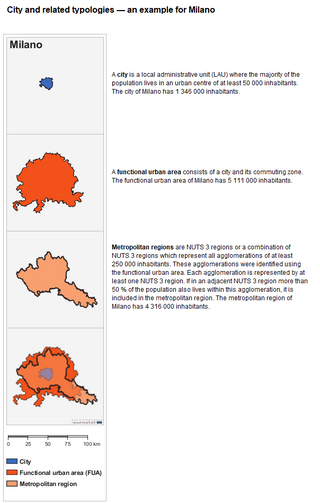
The functional urban area (FUA), previously known as larger urban zone (LUZ), is a measure of the population and expanse of metropolitan and surrounding areas which may or may not be exclusively urban. It consists of a city and its commuting zone, which is a contiguous area of spatial units that have at least 15% of their employed residents working in the city.

Radzionków is a town in Silesia in southern Poland, near Katowice. Outer town of the Metropolis GZM – metropolis with the population of 2 million. Located in the Silesian Highlands.
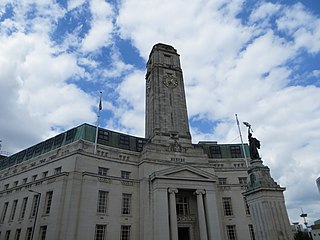
The Luton/Dunstable urban area, according to the Office for National Statistics, is the conurbation including the settlements of Luton, Dunstable and Houghton Regis, in Bedfordshire, East of England.
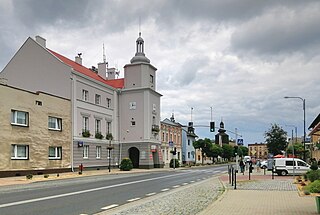
Miasteczko Śląskie is a small town in Upper Silesia in southern Poland, near Katowice. Borders on the Metropolis GZM - metropolis with the population of 2 million. Located in the Silesian Highlands.
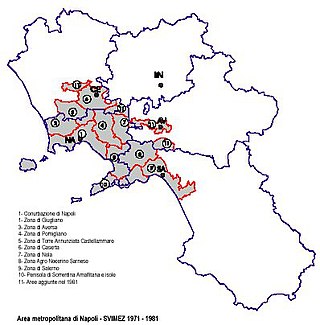
The Naples metropolitan area, or Greater Naples, is a metropolitan area in Campania, Italy, centered on the city of Naples.

The Katowice urban area, also known as the Upper Silesian urban area, is an urban area/conurbation in southern Poland, centered on Katowice. It is located in the Silesian Voivodeship. The Katowice urban area is the largest urban area in Poland and 21st largest urban area in the European Union. According to Demographia, its population is 1,903,000.

The Ostrava metropolitan area is the metropolitan area with the city of Ostrava in the Czech Republic at its center. The Ostrava urban area is the largest urban area in the metropolitan area with a population of 365,000. The metropolitan area has over 81% of the population of the Moravian-Silesian Region. The population of the metropolitan area is 970,189 as of 2024. An alternative definition, the Eurostat Larger Urban Zone, lists a population of 1,153,876. The Ostrava metropolitan area is sometimes combined with the Katowice metropolitan area to form a wider metropolitan area with a population of 5,008,000 (2015). The metropolitan area has 172 municipalities.
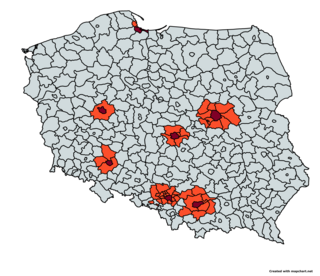
This is a list of metropolitan areas in Poland.
The Cardiff–Newport metropolitan area is a metropolitan area in south east Wales in the United Kingdom. It includes the cities of Cardiff and Newport, with a number of towns in the South Wales Valleys, including Merthyr Tydfil, Pontypridd, Caerphilly, Bridgend and Ebbw Vale. With these outlying settlements the metropolitan area has a population of 1.09 million. Also referred to as the "Cardiff and South Wales Valley metropolitan area", it corresponds to the preserved counties of Gwent and South Glamorgan. It is the largest metropolitan area in Wales, with the next largest being centred on the Swansea Urban Area.

The Vienna-Bratislava metropolitan region is one of 5 polycentric metropolitan areas in European Union. It has population of over 3 million inhabitants and covers an area of around 14,000 square kilometres (5,400 sq mi). It is located in seven administrative units.
